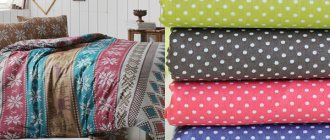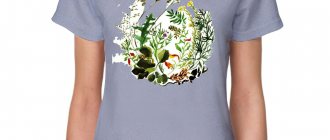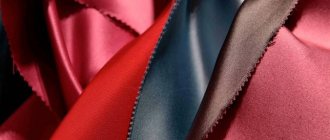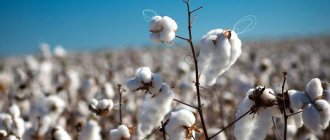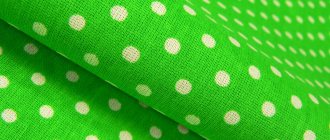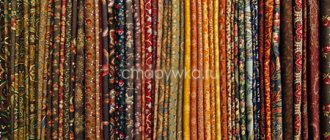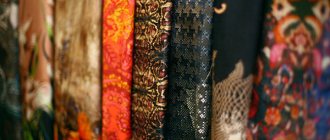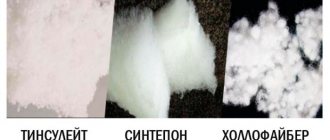Cotton is the crop that has the most limited distribution area. It is grown only in the republics of Central Asia, southern Kazakhstan and Azerbaijan, i.e. in places where the duration of the period with temperatures above 10 degrees Celsius is 140-160 days, the sum of temperatures during this period is 3500-4000 degrees.
Cotton, a crop of dry subtropics, requires an abundance of heat, light, water and high costs of human labor. The conditions of its cultivation and cultivation also affect its physical and mechanical properties.
Cotton is used to produce fine, uniform and durable yarn and is used to make a wide variety of fabrics - from the finest cambric and voile to thick upholstery fabrics.
Cotton is a shrubby annual or perennial plant of the mallow family, which is cultivated as an annual. About 50 species of cotton are known, but only four are of industrial importance: hairy or shaggy, Barbados, tree-like, and grass-like.
The largest volume of cotton production (about 90%) falls on the first type, which is called medium-staple cotton. The fibers of this species are white and have an average length of 30-34 mm. The linear density of the fibers is 166-220 mtex. This cotton is used to produce yarn of linear density from 15.4 to 50 tex, which is used to produce a wide range of cotton fabrics: calico, satin, diagonal.
The second type of cotton is called fine-fiber cotton and produces cream-colored cotton fiber 35-50 mm long. It has especially valuable properties. The fibers of fine-fiber cotton are thin (133-170 mtex), long, silky, and from them you can get yarn of very low linear density, which is used for the production of thin beautiful fabrics - cambric, voile, maya, as well as technical fabrics.
Improving the quality of cotton - increasing the length of the fiber, increasing strength and resistance to disease, as well as increasing the yield of cotton - is achieved through breeding work and improving the entire cotton farming culture.
The entire growth period of cotton from sowing to ripening lasts 100-220 days, depending on the type of cotton and its growth conditions. Cotton harvesting begins when most cotton bushes have ripened and opened a few bolls. Manual and machine cotton harvesting is used.
Depending on the maturity of the fibers, raw cotton is divided into four grades, which are characterized by different elasticity, density to the touch and shades of color. For each variety of raw cotton, standards for contamination and moisture content are also established. Procurement points supply raw cotton to the primary processing plants to which they are assigned.
At cotton primary processing plants, the following operations are performed: pre-cleaning, fiber separation, fiber cleaning and fiber packaging, as well as fluff separation and seed cleaning.
After the sowing seeds are fully prepared, they are packed in paper bags and sent to cotton growing organizations.
Linear density, tex.
Linear density is one of the most important properties of fiber. This value shows how much mass a fiber of a certain length has. Linear density is measured in units - tex.
READ ALSO: To save you need to spend
Tex is the mass in grams per 1 km of fiber (yarn), or in milligrams per 1 m (g/km, mg/m). The linear density of the fiber ultimately determines its transverse dimensions.
The larger the cross-sectional area of the fiber, the greater its linear density. The density of cotton material is 1.5 g/sq.cm.
The linear density of the fibers is very important. The strength of yarn made from fibers depends on the strength of the fibers themselves and on the frictional forces between them. And these forces will be greater, the more contacts between the fibers in its cross section, which in turn depends on the number of fibers. Consequently, the thinner the fibers, that is, the lower their linear density, the more of them there will be in the cross section of a given yarn and the stronger the yarn will be. On the other hand, the finer the fibers, the thinner yarn with normal strength can be obtained from them.
Production technology
The fiber is made from cotton through its special processing. Cotton fiber resembles a piece of cotton wool. The longer it is, the better the quality of the material produced from it (long-staple cotton). But the plant can also have short fibers. Therefore, medium-staple and short-staple cotton are also distinguished. Cotton products also vary in thickness, hairiness and other qualities.
The quality of the resulting material largely depends on the type of fiber weave in it. This way, during manufacturing, different densities, softness and other characteristics are obtained. There are many types of weaves: twill, satin, plain, finely patterned, etc. Using special surface treatment, brushed cotton fabric is obtained. Based on appearance and coloring, the following cotton products are distinguished: plain-dyed, bleached, gray, melange, variegated, and printed.
But it is very rare to find pure cotton fabric. Usually, artificial fibers (acetate, lycra, viscose, polyester) are also added to the composition of the material to reduce its cost and give additional useful qualities in addition to natural ones. These additives give the material resistance to deformation, shine, allow it to wrinkle less and make it more elastic.
At the same time, the percentage of cotton can be different and sometimes it is difficult for a non-specialist to distinguish it. Currently, there is a huge variety of cotton fabrics on the market: satin, chintz, cambric, poplin, velvet, calico, corduroy, flannel, flannel, jacquard and others. This list is constantly updated. Manufacturers, wanting to create ideal fabric, invent more and more new cotton fabrics.
Fiber Strength
The strength of a fiber is its ability to withstand tensile forces. To assess strength, the breaking load is used, that is, the greatest force the fiber can withstand before breaking. The breaking load of the fiber is determined on dynamometers type DSh-ZM2.
To compare the strength of fibers of different linear densities, not absolute, but relative strength is used. To do this, the breaking load must be related to a unit cross-sectional area of the fiber or its linear density. To assess the relative strength of fibers, the breaking length of the fiber is used, that is, the length at which the mass of the fiber is numerically equal to its breaking load.
To assess the quality of cotton fibers as a raw material for the production of yarn, the uniformity of its basic properties is of great importance.
The uniformity of fibers is of great importance for the production of yarn, since the more uniform the fibers, the easier it is to produce uniform yarn from them, which in turn largely determines the productivity of its processing processes and the quality of the fabrics produced.
Cotton fiber adhesiveness
1.1. Classification and structure of cotton fiber
Cotton is a plant fiber that covers the seeds of the cotton plant, a plant of the genus Gossypium. An image of cotton is shown in Fig. 1. Cotton plant (Gossypium) belongs to the mallow family (Malvaceae).
Rice. 1. Cotton plant (Gossypium)
This is an annual shrub plant with large leaves 0.6-1.7 m high, growing in areas with a hot climate. There are 5 cultivated and more than 30 wild species of cotton known [6].
4 types of cotton are predominantly widespread in all countries:
- hairy, or shaggy (medium-fiber - fiber length 26-35 mm);
‒ Barbados - the longest (fiber length 35-60 mm), thin and high-quality fiber, usually slightly creamy in color;
- tree-like (short and coarse fiber);
– grass-like (short and coarse fiber) [6].
Cotton is grown in more than 80 countries around the world. The main cotton producing countries are the USA, India, Pakistan, Egypt, Brazil, China, Uzbekistan, Iran, Afghanistan. Cotton is also grown in the south of Russia, in the Krasnodar region, but only for breeding work [6].
Cotton is amazing because the peoples of the Old and New Worlds began to grow it independently of each other. Columbus and his companions saw the inhabitants of the continent they discovered wearing cotton aprons and scarves that protected their heads from the sun. Later, the Aztec ruler donated 30 bales of cotton cloaks to the Spanish conqueror Cortes. Cotton has been known in India since the 6th century BC. Herodotus wrote that “strange plants grow there, on which wool grows instead of fruit.” In hot climates, people preferred light cotton clothing to thick and heavy linen clothing. Through the Arab market, cotton came to Palestine, Egypt, Andalusia, and Sicily. Until the end of the 8th century, it was imported into Europe only in the form of finished products. The production of cotton fabrics was first opened in 1772 in England [7].
Cotton fiber is the soft, thin, matte hair that covers the surface of the seed. They can be long and fluffy or short and fleecy (lint, or cotton fluff). Depending on the cultivated species and variety, the seed may bear both types of hairs or only the first of them. Each hair is one dead epidermal cell of the seed coat, which is a long, flattened, spirally twisted tube. Wild cotton species do not have long hairs. Cotton fibers can come in different colors. The most common: white with a slight creamy tint, slightly yellowish. Cotton varieties have also been developed that produce greenish, beige or bluish fibers [8].
Cotton fibers are elementary fibers, that is, fibers that cannot be divided into thinner and shorter fibers without destruction. The main characteristics of the macrostructure are length, thickness, and tortuosity [8].
Length is one of the most important characteristics of fiber quality, as it determines the type of yarn obtained and the quality of the products produced. The length of cotton fiber ranges from 1 to 54 mm. Fiber up to 20 mm long is not suitable for making yarn and is called non-spun; it can be used in the production of nonwoven materials and artificial fibers [9].
Cotton with a length of 20 to 54 mm is divided into three grades. The characteristics of cotton fibers of different lengths and yarn made from them are given in table. 19].
The thickness (fineness) of cotton fiber is indicated in micrometers (according to the diameter) or in millitex. The fineness of cotton fibers is in a certain way related to their length; the longer the fiber, the thinner it is:
- fineness of long-staple cotton from 167 to 125 mtex (up to 20 microns);
- fineness of medium-fiber cotton from 200 to 167 mtex (20-23 microns);
- fineness of short-staple cotton from 333 to 222 mtex (more than 23 microns) [9].
During the ripening process, cotton fiber becomes flattened and acquires a corkscrew-like crimp. For fibers of different degrees of maturity and different lengths, the shape of the curls and the degree of crimp are different, while the degree of crimp is higher in fine-fiber cotton (10-12 curls per 1 mm of length), while in medium-staple cotton - 8-9 curls per 1 mm of length [9].
Due to its crimp, the surface of cotton fiber becomes uneven, which reduces its natural shine and also helps retain dirt. At the same time, crimp promotes fiber adhesion and, as a result, increases the strength of yarn and products made from it [9].
Table 1 - Features of cotton yarn of different grades
When examined microscopically, cotton fiber appears as a tube of thin skin (cuticle) that is filled with cellulose. Cellulose is deposited in it in layers (growth rings), leaving an unfilled space inside - a channel. Thus, the fiber walls consist of several layers of cellulose [9].
Linear cellulose macromolecules form a complex structure in the fiber, consisting of various complexes and groups: microfibrils, larger bundles - fibrils, etc. Macromolecules located along the fiber axis are connected to each other by intermolecular bonds. In thinner fibers, the packing of bundles of macromolecules is closer, the intermolecular distances are smaller, as a result of which the binding energy increases several times (when the distance is halved, the intermolecular energy can increase by 8-16 times). These features can explain the greater strength of thin fibers in comparison with thicker ones that have a loose packing of macromolecules. At the same time, cellulose macromolecules in cotton fiber are packed less densely than in other fibers, due to which the structure contains a significant number of submicroscopic pores. The presence of pores is one of the reasons for the good dyeability and high breathability of cotton [9].
Cellulose fibrils are arranged spirally relative to the longitudinal axis, while the direction of the spirals can change and their angle of inclination ranges from 0 to 40°, averaging 23°. Quite a significant elongation at break (7-8%) and strength of a single fiber are due to the indicated features of its supramolecular structure [9].
Under a microscope, cotton fiber exhibits some structural differences depending on the maturity of the fiber. The degree of twist and cross-section of the fiber have a very variable shape and depend on the maturity of the fiber. The properties of the fiber also depend on the degree of maturity. Immature fibers have the appearance of flattened ribbons with thin walls and a wide channel, have low strength, are poorly dyed and are not suitable for processing. As the fibers mature, the walls bounding its channel become clearly visible. A fiber of normal maturity has the appearance of a corkscrew-shaped convoluted tube with developed walls and an internal channel, closed at the side of the natural cone-shaped end of the fiber and open at the point of attachment of the fiber to the seed (Fig. 2). In overripe fibers, the channel is its diameter; crimp almost disappears, they are very hard and brittle [8].
Rice. 2. Appearance of normal maturity cotton fiber
Based on appearance, wall thickness and cross-sectional area, all cotton fibers are divided into 11 groups, designated by maturity coefficients (from 0.0 to 5.0): 0.0; 0.5; 1.0; 1.5; 2.0; 2.5; 3.0; 4.0; 4.5; 5.0 (Fig. 3) [9].
The higher the maturity of the fiber, the higher its quality. The normal maturity of cotton fiber according to the standard is from 3.5 to 4.0. The degree of maturity from 4.5 to 5.0 characterizes overripe fiber (it is less favorable for textile production). For immature fiber, the maturity coefficient is 0.0. Immature and immature fibers are defective [9].
Rice. 3. Appearance of cotton fibers of varying degrees of maturity
Like all structural elements of cotton fiber, the channel performs a specific function. The presence of air in the channel, which is a poor heat conductor, increases the heat-shielding properties of cotton products; the remains of protoplasm serve as a breeding ground for the development of natural microflora of cotton fiber, which causes its damage under conditions of high humidity and temperature [9].
The chemical composition of cotton fiber plays an important role in shaping the properties of cotton and cotton products. The main substance that makes up cotton fiber is cellulose (94-95%). In addition, cotton contains fatty-wax substances (0.65%), pectins (2%), hemicelluloses, protein, ash, dyes and water [9].
Of all organic compounds, cellulose is the most common high-molecular-weight compound, the macromolecules of which consist of a large number of repeating units - 13-glucose residues connected by glycosidic bonds between the first and fourth carbon atoms (Fig. 4) [10].
The number of glucosidic residues reaches 10,000 or more. In the cellulose molecule, the elementary units C6H10O5 contain three chemically active hydroxyl groups OH, which contribute to the emergence of strong intermolecular interactions due to hydrogen bonds, providing significant strength and rigidity of cellulose.
Elongation and elasticity of fibers
Important properties of fibers are also elongation and elasticity. When tensile forces are applied to the fiber, it elongates and becomes deformed.
In this case, two types of deformation are distinguished: reversible, which in turn includes elastic and elastic, and irreversible, or plastic.
Elastic elongation (elasticity) - is associated with small changes in the distances between the particles of the polymers that make up the fibers, and immediately disappears after the load is removed.
READ ALSO: “Phototech Stopfire” - one of the best fire doors
Elastic is an elongation (deformation) that disappears after the load is removed, not immediately, but over time.
Plastic (residual) elongation does not disappear even after the load is removed. Elastic elongation is associated with a change in configuration and rearrangement of macromolecules of fiber polymers. Plastic elongation is caused by the fact that irreversible displacements over relatively large distances occur between the links of macromolecules.
Fiber elongation and especially elasticity is a very valuable property. The more a fiber elongates under a given load, the better it can withstand sudden impacts. The greater the elastic elongation of the fiber, the better the fiber can withstand repeated loads and the longer the product made from it retains its appearance and properties.
Advantages and disadvantages of cotton
Positive characteristics of cotton fabric:
The physical and chemical properties of cotton discussed above allow the material to be washed repeatedly using a wide range of different detergents. Cotton clothing lasts a long time without losing its appearance. The material easily absorbs water and sweat, allowing the skin to breathe, and does not cause allergic reactions. It is easy to care for: wash, bleach, dry, dye.
Negative characteristics:
One hundred percent natural cotton is expensive, it wrinkles very much and is difficult to iron. It shrinks easily when washed in hot water, and also takes quite a long time to dry. If the cotton fabric is of poor quality, it easily pills when worn and quickly takes on an unsightly appearance.
Taking into account all the advantages and disadvantages of the material, we decided to talk about the nuances of caring for it.
Fiber resistance to external factors
The mechanical properties of fibers, such as resistance to abrasion, compression, bending and sliding of one fiber over another, are also of great importance.
The abrasion resistance of fibers is important for two reasons. First, yarn made from fibers with greater abrasion resistance will be better processed into fabric on the loom, where it is exposed to multiple abrasive forces. Secondly, a product (fabric) made from such fibers will have a longer wear life.
Compression resistance is important for the transportation of cotton, since its loose mass is pressed into bales.
The slip resistance of fibers is determined by their surface and the shape of the fibers themselves. In other words, slip resistance depends on the coefficient of friction and the tenacity of the fibers. The larger these values, the greater the force that must be applied to pull apart the fibers in the yarn. Therefore, when the yarn breaks, it will only break when the fibers break. If the fibers were completely smooth and there were no frictional forces between them, then it would be impossible to make yarn from them.
Cotton fiber has a relatively high coefficient of friction and great tenacity. Therefore, cotton produces high-quality yarn of various linear densities. The mutual adhesion of cotton fibers is facilitated by their crimp, which in mature fibers reaches an average of 70-100 crimps per 1 cm.
Care secrets:
- It is better to dry cotton clothes in a well-stretched form, shaking them off vigorously before doing so;
- It is easier to iron cotton products when slightly damp;
- White and multi-colored cotton clothes should be washed separately so that they do not fade;
- Before washing, you can wrap a colored item made of this material in a white cloth and soak it in hot water. This way you will understand whether it fades when washed and whether it is allowed to be washed with other clothes;
- Cotton items should be washed at a temperature of 40–60 degrees. In hot water (especially during the first wash), the fabric “shrinks” and fades;
- Cotton bed linen will smooth out under its own weight if it is folded neatly into a pile.
Hygroscopicity, thermal conductivity, electrical conductivity
Of the physical properties of fibers, the most important are hygroscopicity, color, thermal conductivity and electrical conductivity.
Hygroscopicity is the property of a material to change its moisture content depending on the humidity and temperature of the environment. Fibers contain a certain amount of moisture. As air humidity increases or its temperature rises, the moisture content of the fibers increases, and vice versa. If a fiber has this property, then it is hygroscopic. This remarkable property of fibers largely determines the hygienic and performance properties of fabrics.
The thermal conductivity of cotton fiber is low and the looser the mass, the lower it is. This property is particularly used to make cotton batting.
When dry, cotton fiber has low electrical conductivity, which allows cotton fabrics to be used as insulation. As humidity increases, electrical conductivity increases. Mechanical impacts on cotton create electrostatic charges, which make it difficult to process. Therefore, factories are fighting this phenomenon.
Physical and chemical properties
Cotton fiber is resistant to alkalis, phenol and acetone. Some acids, for example, hydrochloric and sulfuric acids, can easily destroy cotton fabric. The material is not afraid of high temperatures, is quite difficult to tear, and is wear-resistant.
Important: Method for checking naturalness.
Light an inconspicuous edge of the material. The natural product burns with white smoke and emits a paper smell. If the smoke is dark, with a chemical smell, then this is not a cotton fabric or it contains a large percentage of artificial fibers.


